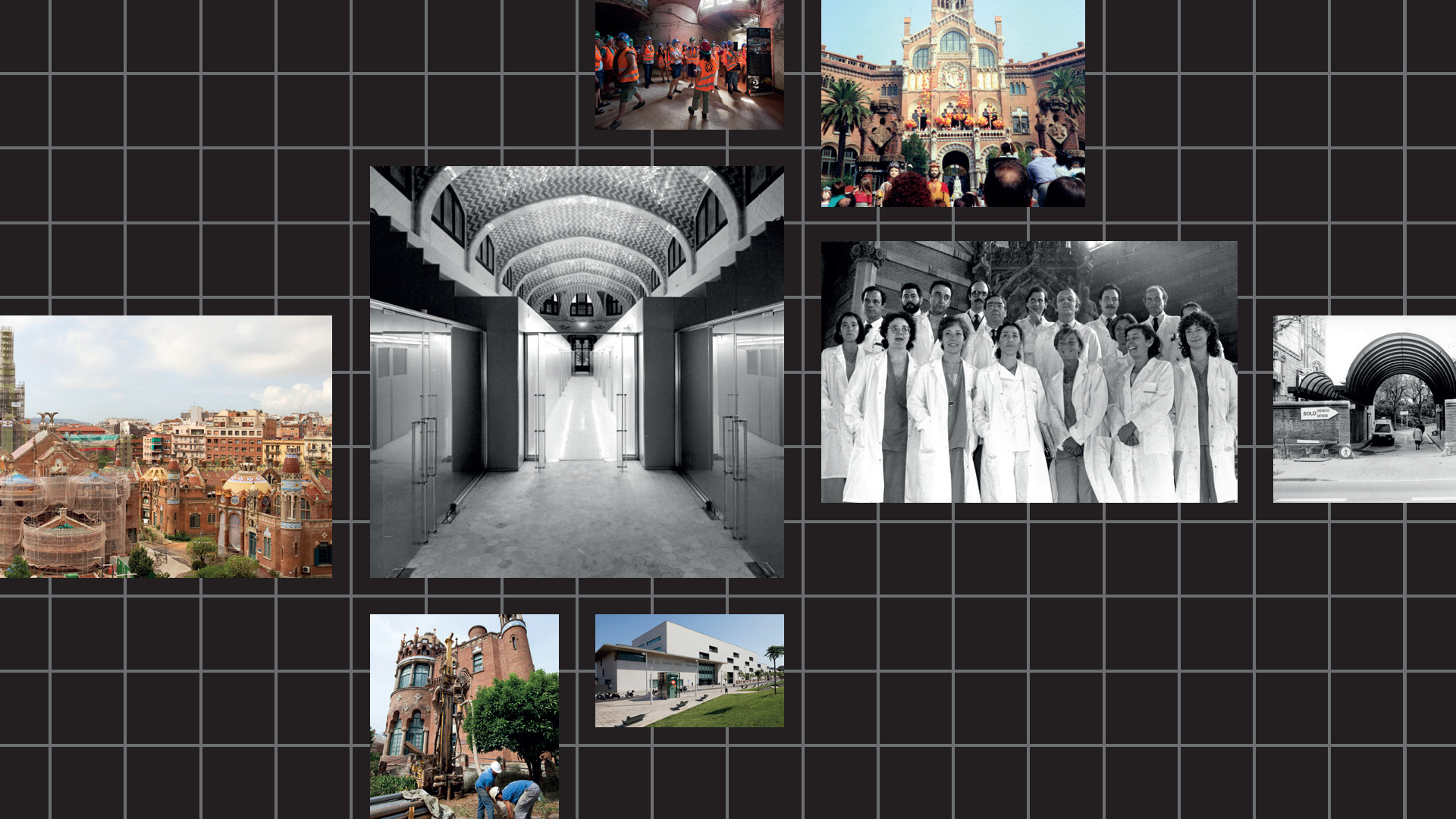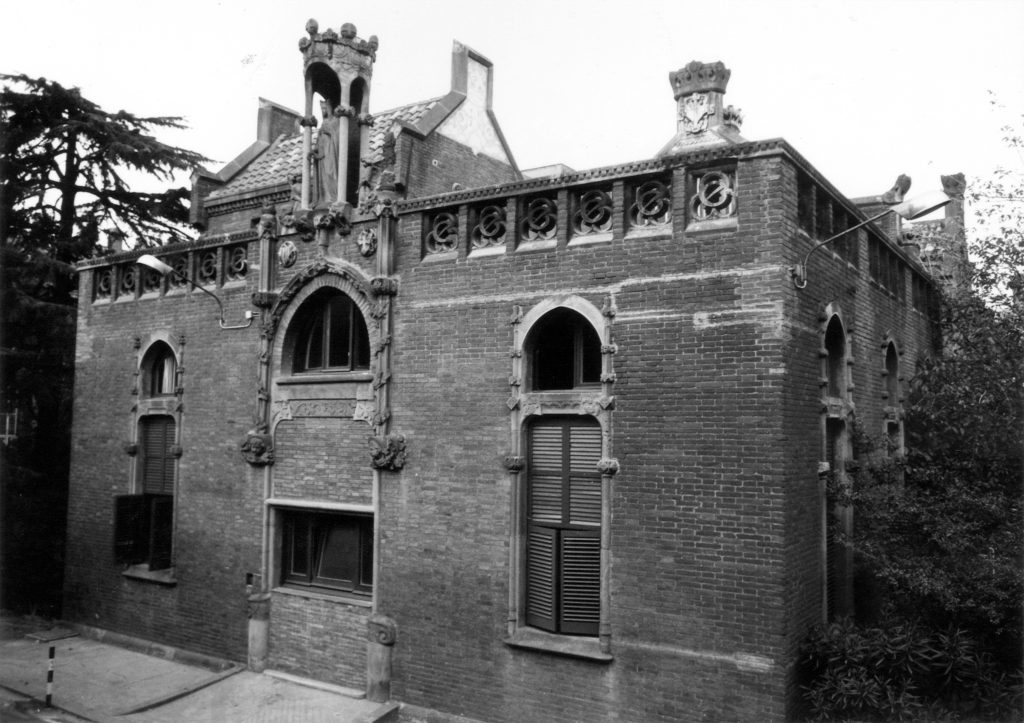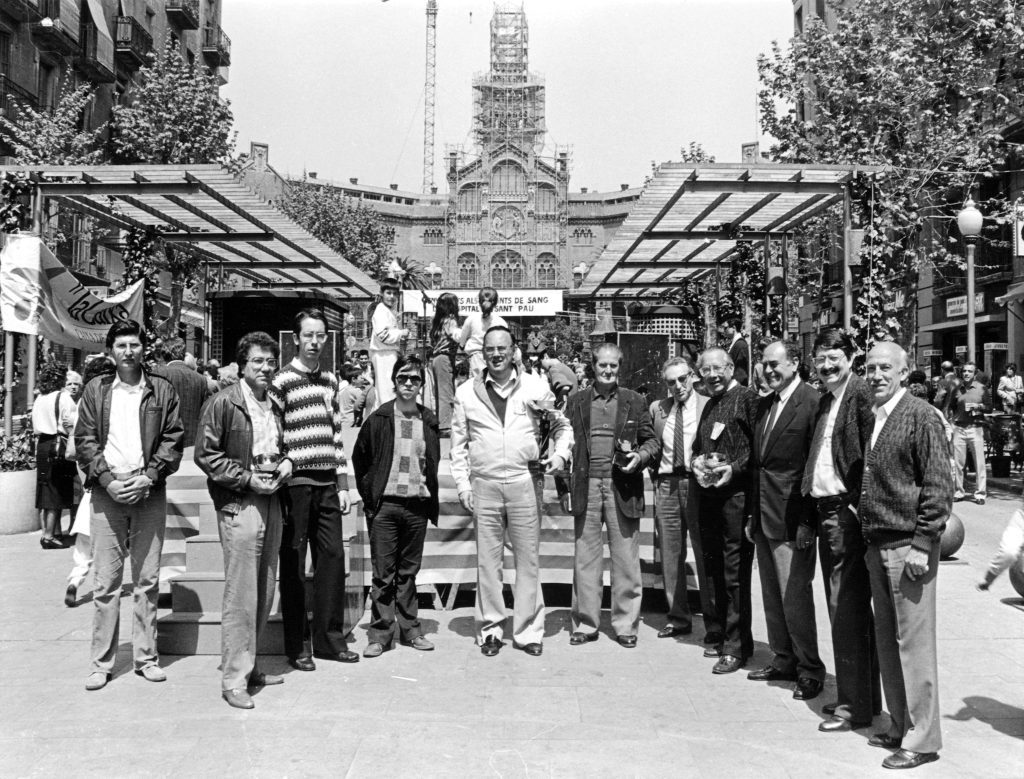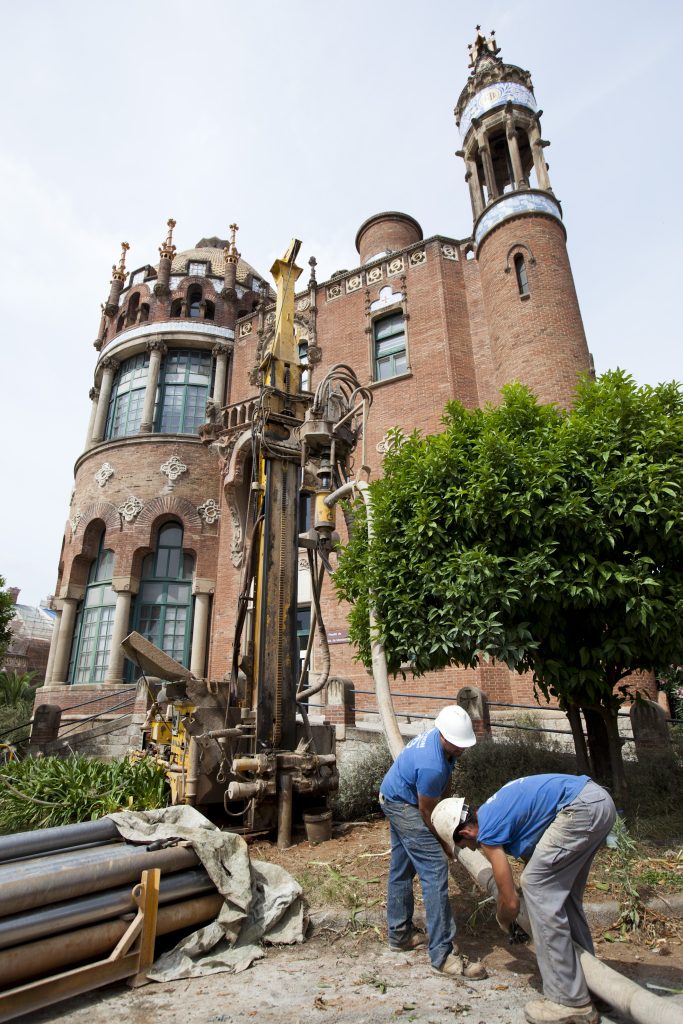ACTIVITIES
Sant Pau: 25 years as a World Heritage site
Thursday, 01 December de 2022 11:00h

Temporary exhibition from December 1, 2022, to March 26, 2023.
Twenty-five years ago, the Hospital de la Santa Creu i Sant Pau was listed as a World Heritage Site by UNESCO. This listing not only marked the starting point for the full restoration of its architectural heritage, but also the culmination of the work begun some 20 years earlier to foster public appreciation of this Art Nouveau site designed by the Catalan architect Lluís Domènech i Montaner.
The work focused on three areas which necessarily had to accommodate each other: the healthcare activity of a leading hospital, the preservation of the architectural heritage of the site, and its opening up towards citizens. Accordingly, the site was recognized as a historical-artistic monument in 1977 and, without ever neglecting the priorities of the hospital, the first restoration and awareness campaigns were gradually launched.
The pursuit of the twin goals of championing heritage and offering excellence in the provision of healthcare was obviously successful; Sant Pau was the only functioning hospital to be listed as a World Heritage Site for its architecture. However, the transfer of the healthcare services to a new, modern building in 2009 proved to be the real catalyst for the restoration of the Art Nouveau pavilions.
A modern hospital within an Art Nouveau complex
Since their inauguration in 1930, the pavilions of the Hospital de la Santa Creu i Sant Pau have undergone several transformations, modifications and additions in response to the healthcare demands of a growing city, and in order to keep pace with the evolution of medical practice over the decades.
By the end of the 1960s, it had become clear that the pavilion structure was unsuited to modern needs. However, due to the lack of funding at that time for the construction of a new building in which healthcare services could be centralized, the only option was to gradually adapt the existing buildings to the required uses.
Hospital activity was the overriding priority in all the aforementioned alterations, which in most cases had an adverse impact on the architectural heritage of the site.

1972. Rear façade of the pavilion of La Puríssima.
The architectural decline of the pavilions can be traced back to the 1950s. Successive alterations and repairs carried out over the ensuing decades completely ignored conservation criteria.

1973. Compartmentalization works of the pavilion of Sant Salvador.
The pavilion interiors were also altered in order to meet the needs of the time and to gain additional spaces.

1974. Extension of the pavilion of Santa Victòria.
In some cases, the need for more space made it necessary to add structures on to pavilions, often with unfortunate results. The one shown here was never completed due to a lack of funds.

1975. Cars parked in the hospital gardens.
By the mid-1970s, the excessive number of vehicles parked in the hospital grounds became problematic, blocking the access of ambulances to the pavilions.

1977. New vehicle entrance on Carrer de Sant Antoni Maria Claret.
In order to reorganize internal traffic, a new vehicle entrance was opened, away from the main entrance and the Art Nouveau pavilions.

1977. The newly decongested hospital gardens.
The reduction in the number of vehicles allowed to park in the gardens (a measure introduced for logistical reasons and in order to improve efficiency in the provision of healthcare services) also halted the architectural decline of the site.
Gaining awareness of architectural heritage
At the end of the 1970s, an awareness of the value of the hospital’s architectural heritage slowly began to take root. However, such concerns were always subservient to healthcare needs, which were naturally the main priority of an active hospital.
This slow awakening occurred in the context of a permanent lack of resources, which only allowed for emergency repairs or the securing of elements at risk of coming loose, exhaustive restoration work being out of the question.
It was during this period that tours of the site were first organized for groups attracted by its architecture. This burgeoning interest in the heritage value of the site culminated in it being listed as a historical-artistic monument by the Spanish government in 1978.

1977. Visit by the French Society of Government Licensed Architects (SADG).
This was the first architectural association to show an interest in Domènech i Montaner’s work and arrange visits to the site.

1978. Damage to the façade of the pavilion of Sant Rafael.
In February 1978, strong winds caused several elements to come loose from the water towers, as a result of the rusting of their metal structure.

1978. Area listed as a historical-artistic monument.
On 19 May 1978, the Spanish cabinet (Council of Ministers) announced its decision to list a set of 19 pavilions of the hospital as a historical-artistic monument, which opened the door to restoring them to their original splendour.
The inception of a conservation policy
Shortly after the site was listed as a historical-artistic monument, a Works Committee was created to centralize all the interventions carried out in the pavilions. However, in early 1979, more architectural elements came loose, highlighting the delicate state of repair of the Art Nouveau site. State intervention was requested in order to restore the site while safeguarding its healthcare activity.
Permanent contacts were established with the Historical-Artistic Heritage Commission of Barcelona to coordinate the conservation and restoration work of the buildings, which began to bear fruit with the restoration of the exterior of the pavilion of La Mercè, the first restoration project in the hospital’s history.

1978. Works in the interior of the Casa d’Operacions (Surgery pavilion).
The remit of the Works Committee, created in 1978, was to oversee the works carried out at the hospital, as well as to monitor the state of repair of the pavilions and manage their restoration (including its funding).

1980. Exterior restoration of the pavilion of La Mercè.
The restoration of the exterior of this pavilion was made possible by a funding package of five million pesetas provided by the Spanish Ministry of Culture.

1980. Restored interior of the pavilion of La Mercè.
The interior of the pavilion was remodelled, adopting conservation and reversibility criteria, in order to house the Obstetrics Department, which was provided with more modern equipment.
Promoting heritage among citizens
In 1981, the hospital launched a public promotion plan aimed at raising awareness of its cultural and healthcare facets among citizens. Exhibitions began to be organized, both at the Sant Pau site itself (where an exhibition hall was inaugurated) and elsewhere.
The first organized individual or group tours (including school tours) were also scheduled. Furthermore, the gardens were redeveloped, with the incorporation of new vegetation, and the central promenade was turned into a pedestrian island, permanently closed to vehicle traffic.
Coinciding with its new public prominence, in 1980 the hospital received the prestigious FAD architecture award in the restoration category for the intervention carried out in the pavilion of La Mercè.

1981. Tribute to Pau Gargallo.
As part of the programme of activities organized to celebrate the centenary of the sculptor’s birth, this was the first major high-profile public event held at the hospital.

1981. First school tour of the hospital.
As part of its public awareness plan, the hospital began to organize tours of the site for schools, showing both its architectural heritage and its hospital activity.

1981. Exhibition on children’s health education.
The hospital organised all sorts of exhibitions for the general public on a wide variety of themes such as art, historical heritage, architecture or medicine.

1982. Tour of the hospital by the Friends of Museums association.
Scheduled tours became firmly established in 1982, mainly by cultural organizations such as the Friends of Museums association or the Friends of Historical Barcelona association.

1982. Inauguration of the exhibition hall.
An exhibition hall was inaugurated in the vestibule of the Administration pavilion, housing arts and educational exhibitions for the general public.

1983. Traffic-free hospital gardens.
The central promenade was permanently closed to vehicle traffic and turned into a pedestrian island in order to facilitate ambulance access between the pavilions.
The restoration of a leading hospital
The mid-1980s saw the start of a restoration project which at that time was the most important in the hospital’s history: the restoration of the façade and interior of the Administration pavilion, for which the Government of Catalonia allocated 41 million pesetas of funding.
As far as the remaining pavilions were concerned, apart from the demolition of some added structures, at this time it was only possible to secure, clean up and weatherproof the elements at risk of coming loose.
These interventions were carried out in parallel with cultural tours. However, both activities were carefully planned so as not to interfere with the day-to-day running of the hospital, one of Spain’s most innovative healthcare institutions: the country’s first bone marrow transplant and heart transplant were performed here, in 1976 and 1984, respectively.

1984. Restored exterior of the pavilion of Santa Victòria.
In accordance with the criterion of respecting the original architecture of the pavilions, the unfinished structure added to the pavilion of Santa Victòria in 1974 was demolished.

1984. The team that performed Spain’s first successful heart transplant.
Meanwhile, the hospital continued to practice cutting-edge medicine. At this time it was one of just over 20 centres in the world where heart transplants were performed.

1984. Scaffolding on the façade of the Administration pavilion.
The process of restoring the façade, undertaken by the Ministry of Culture of the Government of Catalonia, was designed so as not to interfere with the day-to-day running of the hospital.

1985. Restoration of the vestibule.
The main stairway and vestibule of the Administration pavilion were restored between June 1984 and January 1986, reclaiming the space filled until then by the exhibition hall.

1986. Dismantling of the clock tower.
The clock tower was in such a poor state of repair that the restoration team had to dismantle it in order to shore it up and ensure its future conservation.

1986. New entrance to the Casualty Department.
With the restructuring of the Casualty Department, a new side entrance was created and the access point through the entrance square, established in 1967, was permanently closed off.
Agreement for a restoration plan
In 1987, while the restoration of the clock tower was still underway, the hospital management approved a plan for the restoration and conservation of the Art Nouveau pavilions adopting the criterion of respecting their original architecture.
The following year, this plan received the full backing of the Government of Catalonia, Barcelona Provincial Council and Barcelona City Council, which agreed to conduct a comprehensive study of the state of repair of all the buildings in the hospital complex.
This marked the start of exhaustive work to restore the exteriors of the pavilions for patients (rotundas, water towers, ceramic elements, roofs) and, from 1990, the church building.

1987. Tribute to blood donors on the occasion of the Festa Major (Main Festival) of the Sagrada Família neighbourhood.
Through its Sociocultural Committee, the hospital partnered with local neighbourhood associations to organize activities, talks or sports competitions.

1988. Restoration of the rotunda of the pavilion of La Mercè.
With the approval of the restoration plan, the state of repair of all the façades was studied and work got underway to restore all the exterior elements.

1989. Community party to celebrate the inauguration of the clock tower.
The completion of the clock tower works was celebrated with a community party in partnership with local neighbourhood associations, involving traditional papier-mâché giants, grallers and the flying of balloons.
A new hospital on the horizon
In 1990, the Government of Catalonia joined the Most Illustrious Administration, the governing body of the hospital, with an undertaking to construct a new building to finally overcome longstanding functional deficiencies. While the project was being executed, however, the hospital’s most immediate needs had to be met by building new structures to house medical services.
Meanwhile, making the most of the momentum generated by the city’s hosting of the 1992 Olympic Games, the hospital published information guides to promote cultural visits to its facilities by local residents and tourists. The heritage value of the hospital pavilions was officially recognized in 1997 when Sant Pau was listed as a UNESCO World Heritage site.

1990. The Government of Catalonia joined the hospital’s Most Illustrious Administration.
In the joining agreement, the Government of Catalonia undertook to construct a large modern building to house the medical and healthcare activities of the hospital.

1991. George Lucas during the shoot of “The Young Indiana Jones Chronicles”.
In the 1990s, Sant Pau was often used as a location for film and television productions, which were scheduled in such a way as to interfere as little as possible with the hospital’s activity.

1992. Scale model of the project for the new hospital.
The new hospital, with a planned capacity of 750 beds, would enable the medical services to be moved out of the Art Nouveau pavilions, which were not very suitable for the practice of modern medicine.

1992. Visit by the UNESCO Committee for the study and conservation of Art Nouveau architecture.
The visit by this international committee to evaluate the condition of the site was crucial for its subsequent listing as a World Heritage site.

1995. Restoration of the entrance fence.
The restoration project continued apace, including (among other works) the restoration of the rotunda of the pavilion of Montserrat and of the fence in the entrance square.

1995. Construction of the prefabricated outpatients’ building.
While the new hospital was being built, the need for additional space was met through the installation of prefabricated buildings and interventions in the pavilions of lesser architectural value.

1997. Tile commemorating the listing of Sant Pau as a World Heritage site.
On 4 December 1997, in Naples, UNESCO announced the listing of the Hospital de la Santa Creu i Sant Pau and the Palau de la Música Catalana (Palace of Catalan Music), both designed by the architect Lluís Domènech i Montaner, as World Heritage sites for their “exceptional universal value”.
Considered masterpieces of the Catalan Art Nouveau style, their exceptional importance lies in their contribution of new architectural, typological and artistic solutions.
The construction of the new hospital
The hospital entered the 21st century with the successful tender award of the works for the new building, which got underway in 2001. The 600th anniversary of the foundation of the old Hospital de la Santa Creu was also celebrated that year with an extensive programme of institutional events, exhibitions and talks, along with recreational and cultural activities.
The building works progressed satisfactorily and in 2003 the first phase was completed and inaugurated. This included the outpatient’ unit, the day hospital, operating theatres and the same-day surgery unit. The project was finally completed in 2009, with the transfer of the remaining clinical services from the Art Nouveau pavilions to the new building.
Meanwhile, a master plan was commissioned in 2006 to assess the condition of the pavilions and draw up a roadmap for their restoration.

2001. Community party to celebrate the 600th anniversary of the Hospital de la Santa Creu.
The hospital’s 600th anniversary was celebrated with a wide variety of institutional, cultural and community activities aimed at bringing the institution closer to citizens.

2003. The new hospital under construction.
In 2001, work got underway on the new hospital building. The first phase was completed and inaugurated in 2003, but the final works were not completed until 2009.

2004. Recovery of the hospital gardens.
With the transfer of the first few services to the new hospital building, the gardens were redeveloped after removing the prefabricated buildings that had occupied them since 1967.

2004. Restoration of the pavilion of La Mercè.
In 2004, while work was being carried out on the roof, the dome of the pavilion of La Mercè collapsed. It became clear that a careful evaluation of the condition of all the pavilions was necessary before continuing with the intervention.

2009. Transfer of the Neonatal Unit to the new hospital.
Between June and July 2009, the transfer of the hospital’s clinical services to the new building was completed, leaving the historical pavilions empty.

2009. The new Hospital de la Santa Creu i Sant Pau.
The new 83,000 m² hospital building was officially inaugurated on 3 July. Within a few days, all the medical services and units were fully operational.
The restoration of the Art Nouveau Site
The master plan for the restoration of the site was completed in 2008 and the Heritage Committee of the Art Nouveau Site was created in April 2009, incorporating representatives of the Government of Catalonia, Barcelona City Council and Barcelona Provincial Council in order to ensure institutional coordination.
The highly complex works began in October 2009, encompassing a gross floor area of 29,517 m², 31,052 m² of outdoor space, 12 pavilions and one kilometre of underground galleries. Four work phases were planned: the recovery of the original building volumes, the shoring up of structural elements, the design of facilities and, finally, the comprehensive restoration of the buildings.
In the space of five years, 75 million euros were invested, of which 62% was institutional funding from Barcelona City Council, Barcelona Provincial Council, the Government of Catalonia, the Government of Spain and the European Union.

2009. Rotunda of the pavilion of Sant Salvador after the transfer of activity.
In October 2009, with the pavilions now empty of activity, restoration work began on the 12 Art Nouveau pavilions with the greatest architectural value.

2011. Interior of the Cambó Room during the restoration works.
The first goal of the intervention was to restore the buildings to their original volumes, removing adjoining constructions and non-original intermediate floors, among other elements.

2011. The Art Nouveau Site with restoration works well underway.
In the second phase, priority was given to shoring up the buildings, roofs, domes and façades, as well as their supporting metal structures.

2011. Restoration of the mosaics on the façade of the Administration pavilion.
Between 2009 and 2014, the restoration process involved 67 teams of architects, 25 engineering offices, 103 construction companies, 20 restoration companies and three stonemasons.

2011. Guided tour of the restoration works of the Art Nouveau Site.
While the works were underway, an effort was made to keep the general public involved by offering guided tours of the ongoing restoration process.

2012. Drilling of a geothermal well in front of a pavilion.
In accordance with sustainability criteria, the largest geothermal energy production complex in Southern Europe was installed on the site, comprising more than 350 wells.
The Art Nouveau Site opens up to the city
With six of the 12 pavilions fully restored, in 2014 the Art Nouveau Site opened to local residents and tourists with a cultural programme and a schedule of tours aimed at showing its Art Nouveau heritage, the importance of its architect, Lluís Domènech i Montaner, and the history of the institution behind it all. Within the space of a few short years, this heritage complex has become one of the most visited tourist attractions in Barcelona.
The restored pavilions now serve to accommodate organizations with a significant social impact in the fields of innovation, sustainability, health and culture. Here they carry out research, cooperation and training projects, as well as organizing a wide variety of national and international dissemination events.
With the Art Nouveau Site fully operational, the renovations continued apace: between 2014 and 2017, five million euros were invested in restoring the Casa d’Operacions (Surgery pavilion) and the pavilion of Sant Salvador. In 2022 work began on the pavilion of La Puríssima…

2014. Inauguration of the Art Nouveau Site.
The restored site was inaugurated in February 2014. The institutional event was attended by the Archbishop of Barcelona, the Mayor of Barcelona and the President of the Government of Catalonia.

2014. Open doors day on the occasion of the inauguration.
More than 125,000 people visited the Art Nouveau Site over the course of two weeks of open days organized on the occasion of the inauguration.

2015. Restoration of the interior of the Casa d’Operacions (Surgery pavilion).
With the Art Nouveau Site now open to the public, the restoration works continued: the restoration of the Casa d’Operacions was completed in 2015, and that of the pavilion of Sant Salvador in 2016.

2017. Exhibition area of the pavilion of Sant Salvador.
Once the pavilion had been restored to its original appearance, it was used as an exhibition space dedicated to the history of the hospital and to the architect Lluís Domènech i Montaner.

2017. Swing dancing at an open doors day.
In addition to tours, all sorts of cultural activities are organized at the Art Nouveau Site, such as talks, exhibitions, educational sessions or concerts.

2022. The pavilion of La Puríssima (Our Lady of the Immaculate Conception) with restoration works well underway.
The restoration of the pavilion of La Puríssima got underway in 2022. The works have a budget of over two million euros and a completion schedule of 10 months.
SANT PAU: 25 years as a World Heritage site
Research
Arxiu Històric de l’Hospital de la Santa Creu i Sant Pau
Images
Arxiu Històric de l’Hospital de la Santa Creu i Sant Pau
Fundació Privada Hospital de la Santa Creu i Sant Pau


 Tickets
Tickets


